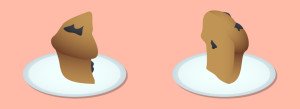10 Portion Control Tips
 Today’s portion sizes are easily 2-3 times larger than 20 years ago. A typical blueberry muffin in the 90s weighed 1.5 ounces and contained 210 calories. Today’s muffins usually weigh 5 ounces and pack 500 calories. Plates, bowls, and cups are also larger today, subliminally encouraging us to serve and consume bigger portions.But there’s good news! Research from the Cornell University Food and Brand Lab shows that we’re satisfied eating less as long as the portions we serve ourselves are smaller.Use these 10 tips to shrink portion sizes and decrease your calorie intake. You’ll still get to enjoy your food too!
Today’s portion sizes are easily 2-3 times larger than 20 years ago. A typical blueberry muffin in the 90s weighed 1.5 ounces and contained 210 calories. Today’s muffins usually weigh 5 ounces and pack 500 calories. Plates, bowls, and cups are also larger today, subliminally encouraging us to serve and consume bigger portions.But there’s good news! Research from the Cornell University Food and Brand Lab shows that we’re satisfied eating less as long as the portions we serve ourselves are smaller.Use these 10 tips to shrink portion sizes and decrease your calorie intake. You’ll still get to enjoy your food too!
- Use a smaller spoon to serve high-calorie foods like casseroles, potatoes, and desserts. Save the large serving spoons for lower-calorie foods like fruit and vegetables. Research shows that using a large serving spoon results in eating 14% more food.
- Downsize your plates and bowls. Serving from a larger bowl results in people eating an average of 31% more food.
- Divide muffins, cookies, and bagels into smaller portions. Share them with friends or wrap up extras for a later meal or snack.
- Automatically remove one piece of fried food from your plate. Eating one fewer piece of these high-fat foods won’t prevent feeling full, and purposefully downsizing leads to routinely eating smaller portions.
- Order the smallest size available.
- Serve meals restaurant-style instead of family-style and you’ll eat 20% fewer calories.
- Brian Wansink, PhD, author of Mindless Eating: Why We Eat More than We Think, recommends using dark-colored plates when eating higher-calorie white foods such as mashed potatoes or pasta. The higher contrast in color between the food and the plate resulted in people eating 18% less food.
- Here’s another Wansink tip: use tall, slender glasses instead of short, wide glasses for drinks like juice and smoothies. We tend to pour more into short, wide glasses since we focus more on height than width.
- Cut large pieces of food such as meat, baked potatoes, lasagna, and pancakes into smaller, bite-sized pieces. Smaller pieces of food piled together gives the impression of a large serving, and we eat less when the pieces are smaller.
- Chew those small bites of food longer, and you’ll find you’re satisfied with eating less. More chewing helps us feel satisfied when eating smaller amounts of food.
By Lynn Grieger RDN, CDE, CPT, CWCReferences:
- National Heart Lung and Blood Institute: Serving Sizes and Portions. http://www.nhlbi.nih.gov/health/public/heart/obesity/wecan/eat-right/distortion.htm updated September 30, 2013. Accessed 2-6-14.
- Cornell University Food and Brand Lab. Smaller snacking is smart snacking. Accessed 2-9-14. http://foodpsychology.cornell.edu/outreach/smallsnack.html
- Ice Cream Illusions: Bowls, Spoons, and Self-Served Portion Sizes. Wansink, van Ittersum, Painter. American Journal of Preventive Medicine volume 31, issue 3. Pages 240-243, September 2006.
- How To Eat Less: Becoming Portion Aware. http://www.cookinglight.com/healthy-living/healthy-habits/healthy-habits-hero-brian-wansink-00412000077626/ October 2012. Accessed 2-6-14.
- Cornell University Food and Brand Lab. Bottoms Up! The Influence of Elongation & Pouring on Consumption Volume http://foodpsychology.cornell.edu/summaries/pouring Accessed 2-9-14.
- Oral processing characteristics of solid savoury meal components, and relationship with food composition, sensory attributes and expected satiation. Forde, van Kuijk, Thaler, de Graff, Martin. Appetite 2013 Jan;60(1):208-19.


